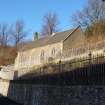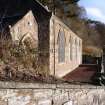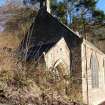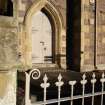New Lanark Community Hall, New Lanark
Ordnance Survey licence number AC0000807262. All rights reserved. © Copyright and database right 2024. Public Sector Viewing Terms
Useful Links
- Canmore:
- NEW LANARK, NEW LANARK ROAD, NEW LANARK CHURCH
- Historic Scotland:
- HS Reference No 37037
- World Heritage Site:
- New Lanark
General Details and Location
Category
AT RISK
Name of Building
New Lanark Community Hall
Other Name(s)
New Lanark Church (Former)
Address
New Lanark
Locality
Postcode
Planning Authority
Divisional Area
Reference No
5195
Listing Category
A
OS Grid Ref
NS 88014 42650
Location Type
Rural Settlement
HS Reference No
37037
Description
Single storey, 4-bay, rectangular-plan, simple Gothic church with W gable belfry and porch adjoining W gable, at right angles to main axis of church. Snecked pink sandstone with polished yellow ashlar dressings. Base course, eaves course. Long and short quoins. Regular fenestration to N & S elevations with roll-moulded hoodmoulds and tabbed, chamfered margins. 2-leaf timber-boarded door to gabled lobby-porch. Cross finial to E gable.
Ecclesiastical building no longer in use as such (since 1971). It was sold by the Church of Scotland to the New Lanark Association Ltd in 1974 and now serves as a community hall. The church occupies a very prominent position at the bottom of the main footpath entering New Lanark. Though simple in design the detailing of the church is good both inside and out and reflects the training and early years of the architect Thomas Carlaw. Carlaw was born in 1851 and trained as a joiner. By the 1880s he was running a successful joinery business in Lanark though clearly he was willing to turn his hand to a variety of jobs, as he is variously described as joiner, cartwright and clerk of works. He may have been responsible for the design of the new school in New Lanark which was opened in 1884; certainly he is listed with his partner 'Murray' (probably a member of his future wife's family) as undertaking the joinery work there.
The church post-dates Dale's and Owen's involvement with the village by more than 50 years. The fact that they did not provide a church for the mill-workers (other than the New Buildings and later the Institute for the Formation of Character, where religious services of sorts could be held) indicates Dale's attitude to the established church and Owen's strong opposition to organised religion. David Dale had deep religious beliefs and founded the Old Scotch Independents, known as Daleites. He did not approve of the established church but provided meeting rooms for his and three other sects in the village. Owen denounced what he described as 'absurd and irrational forms of religion' but made some provision for religious observance in the Institute.
Henry Birkmyre, proprietor of the Gourock Ropework Company who acquired the mills in 1881, was a staunch supporter of the United Presbyterian Church. He was keen that the workers attended formal church services and tangled with the workers over the provision of a church. In the end he gave the site for the church free of charge as well as paying for the installation of electric power. The foundation stone was laid on 15 October 1898 and it was opened in June 1899. The church provided accommodation for 250 people and cost £1200, much of which was raised by subscription.
New Lanark village is made up of industrial, residential and community buildings, dating predominantly from between 1786 and the 1820s. The mill complex was founded by David Dale, Glasgow merchant, in conjunction with Richard Arkwright, trailblazing inventor of the cotton industry. Dale's humane philosophy was expanded by Robert Owen, who took over management of the mill village in partnership from 1799-1825. The mills were in operation from 1786 to 1968. (Historic Scotland)
Ecclesiastical building no longer in use as such (since 1971). It was sold by the Church of Scotland to the New Lanark Association Ltd in 1974 and now serves as a community hall. The church occupies a very prominent position at the bottom of the main footpath entering New Lanark. Though simple in design the detailing of the church is good both inside and out and reflects the training and early years of the architect Thomas Carlaw. Carlaw was born in 1851 and trained as a joiner. By the 1880s he was running a successful joinery business in Lanark though clearly he was willing to turn his hand to a variety of jobs, as he is variously described as joiner, cartwright and clerk of works. He may have been responsible for the design of the new school in New Lanark which was opened in 1884; certainly he is listed with his partner 'Murray' (probably a member of his future wife's family) as undertaking the joinery work there.
The church post-dates Dale's and Owen's involvement with the village by more than 50 years. The fact that they did not provide a church for the mill-workers (other than the New Buildings and later the Institute for the Formation of Character, where religious services of sorts could be held) indicates Dale's attitude to the established church and Owen's strong opposition to organised religion. David Dale had deep religious beliefs and founded the Old Scotch Independents, known as Daleites. He did not approve of the established church but provided meeting rooms for his and three other sects in the village. Owen denounced what he described as 'absurd and irrational forms of religion' but made some provision for religious observance in the Institute.
Henry Birkmyre, proprietor of the Gourock Ropework Company who acquired the mills in 1881, was a staunch supporter of the United Presbyterian Church. He was keen that the workers attended formal church services and tangled with the workers over the provision of a church. In the end he gave the site for the church free of charge as well as paying for the installation of electric power. The foundation stone was laid on 15 October 1898 and it was opened in June 1899. The church provided accommodation for 250 people and cost £1200, much of which was raised by subscription.
New Lanark village is made up of industrial, residential and community buildings, dating predominantly from between 1786 and the 1820s. The mill complex was founded by David Dale, Glasgow merchant, in conjunction with Richard Arkwright, trailblazing inventor of the cotton industry. Dale's humane philosophy was expanded by Robert Owen, who took over management of the mill village in partnership from 1799-1825. The mills were in operation from 1786 to 1968. (Historic Scotland)
Building Dates
1898-99
Architects
Thomas Carlaw
Category of Risk and Development History
Condition
Fair
Category of Risk
Low
Exemptions to State of Risk
Field Visits
17/12/2013
Development History
August 2011: Nominated for inclusion on the Register by SBPT. Intermittently in use as a community centre since deconsecration in 1971, a number of cracks have appeared in walls, potentially linked to issues with the building's foundations. SBPT is to carry out an Options Appraisal to identify a sustainable new use in conjunction with a scheme of repairs/ outlined costs. For Investigation.
17 December 2013: External inspection finds the building appears to be in fair overall external condition and being maintained. The building is potentially under-used. Strathclyde Building Preservation Trust, on behalf of New Lanark Trust, completed an Options Appraisal for the building which identified short-term holiday lets as the preferred end-use. SBPT has encouraged the New Lanark Trust to look in more detail at the surrounding slope and work with an engineer to establish the perceived instability of the slope and the surrounding retaining walls. The work that will be required on this slope may be a deciding factor in the future of this project.
4 March 2014: New Lanark Trust advise that the property, latterly in use as a community hall, has now been mothballed. The Trust is currently pursuing the restoration of the A-listed terrace of tenements, Double Row, for which they have been awarded a stage 1 pass towards funding through the Heritage Lottery Fund. Moved to At Risk.
25 August 2023: Repairs and consolidation of the boundary wall were completed as part of the Conservation Area Regeneration Scheme. The hall remains mothballed.
Guides to Development
Conservation Area
New Lanark
Planning Authority Contact
PAC Telephone Number
07551839698
Availability
Current Availability
Not Available
Appointed Agents
Price
Occupancy
Vacant
Occupancy Type
N/A
Present/Former Uses
BARR original text : Church/Convent/Monastery to Community Hall
Name of Owners
New Lanark Trust
Type of Ownership
Charity/Trust
Information Services
Additional Contacts/Information Source
Bibliography
Online Resources
Classification
Churches and Chapels
Original Entry Date
28-DEC-11
Date of Last Edit
23/07/2018







